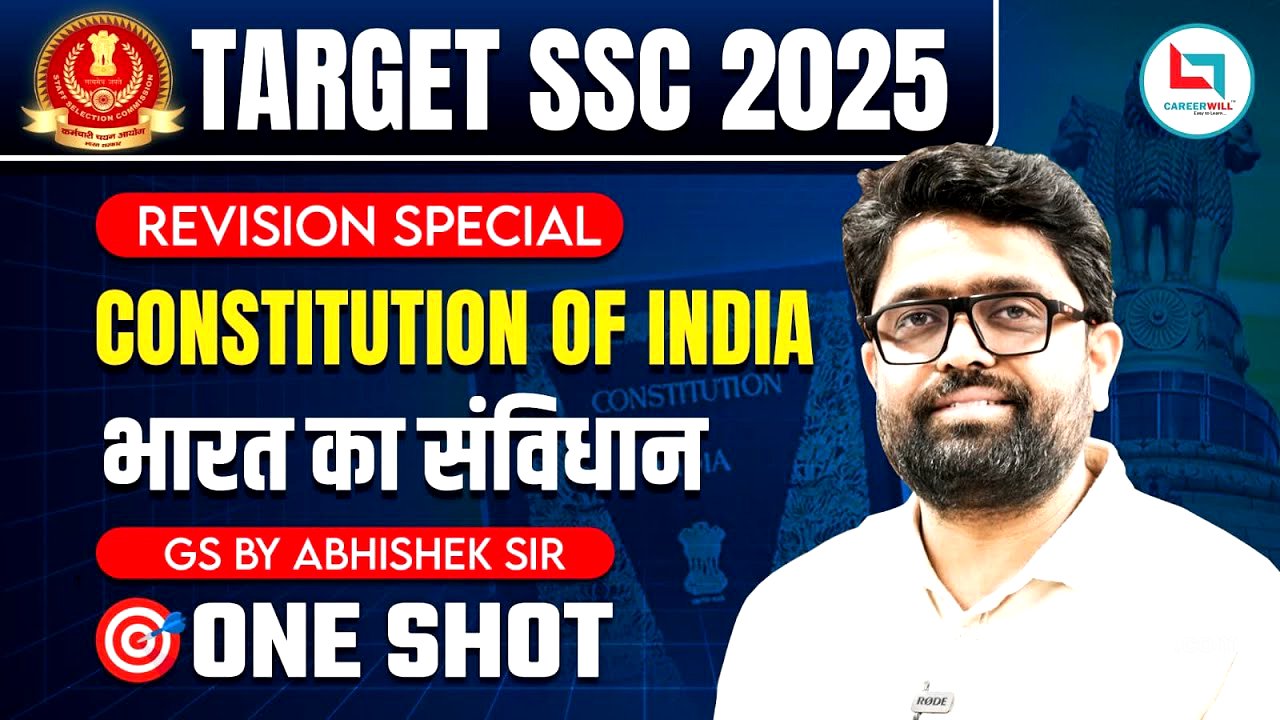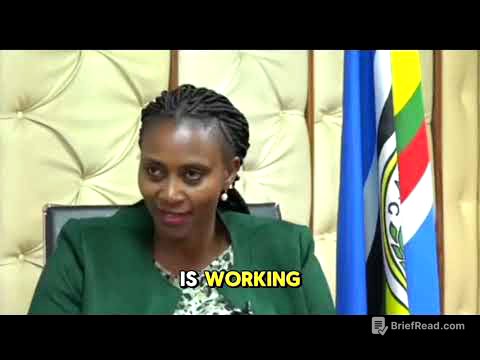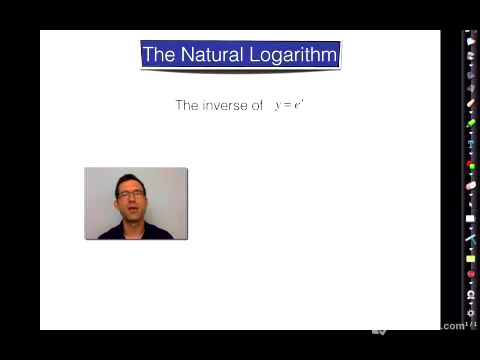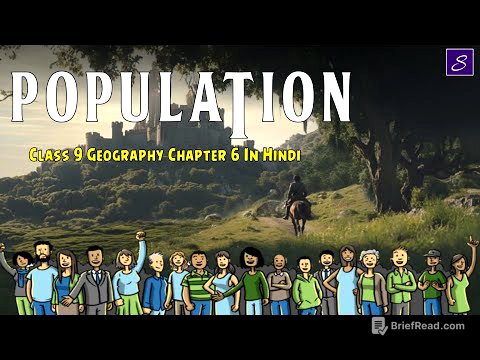TLDR;
This YouTube video by Abhishek Suman GS provides a comprehensive overview of the Constitution of India. It covers the preamble, parts, articles, and schedules, offering valuable insights for competitive exam aspirants. The video emphasizes key amendments, important articles, and the structure of the Indian Constitution.
- Preamble: Discusses the evolution, key words, and significance.
- Parts and Articles: Explains the 25 parts and over 450 articles, detailing important provisions.
- Schedules: Describes the 12 schedules, their contents, and related articles.
Introduction [0:06]
Abhishek Suman welcomes viewers to a session focused on the Constitution of India, designed to address various problems and provide information for competitive exams such as UPSC, SSC, and Railway exams. The session aims to cover the entire constitution in one video, including all parts, schedules, and paragraphs of the preamble.
Preamble [3:21]
The discussion begins with the preamble, noting its drafting by Pandit Jawaharlal Nehru and its presentation on December 13, 1946. The original preamble and its evolution, including the addition of the words "socialist," "secular," and "integrity" in 1976 under the 42nd Constitutional Amendment Act, are examined. The preamble's declaration of "We the People of India" signifies the constitution's source and its commitment to a sovereign, democratic republic. The three types of justice (social, economic, and political), liberty, equality, and fraternity are mentioned as the objectives. The Supreme Court's view of the preamble as a part of the Constitution, subject to amendment without disturbing the basic structure, is also highlighted.
Parts and Schedules [16:34]
The video transitions to the parts and schedules of the Indian Constitution. Initially, in 1950, there were 22 parts, which have now increased to 25. Part 1, "The Union and its Territory," covers articles 1-4. Part 2 addresses citizenship (articles 5-11), drawing provisions from Britain and emphasizing single citizenship. Part 3 details fundamental rights (articles 12-35), inspired by the US Constitution. The deletion of the Right to Property as a fundamental right is mentioned, along with the six remaining fundamental rights: equality, freedom, against exploitation, freedom of religion, cultural and educational rights, and constitutional remedies. Part 4 covers the Directive Principles of State Policy (DPSP) (articles 36-51), taken from the Irish Constitution. Part 4A introduces fundamental duties, added in 1976 under the 42nd Amendment, based on recommendations from the Swarn Singh Committee. Part 5 discusses the Union, divided into chapters such as the Union Executive (articles 52-78), Parliament (articles 79-122), and the Union Judiciary. Part 6 focuses on the state, covering articles 152-237, and is referred to as the "Constitution of States."
Schedules of the Constitution [36:45]
The video explains that schedules are tables not mentioned in the articles but referred to separately. Originally, there were eight schedules, now increased to twelve. The First Schedule lists the names of Indian states and union territories. The Second Schedule outlines provisions related to the salaries, allowances, and pensions of officials like the President, Governors, and judges. The Third Schedule contains formats for oaths and affirmations taken by various officials. The Fourth Schedule allocates seats in the Rajya Sabha for states and union territories. The Fifth Schedule addresses the administration and control of scheduled areas and tribes. The Sixth Schedule provides special provisions for the administration of tribal areas in Assam, Meghalaya, Tripura, and Mizoram. The Seventh Schedule includes the Union List, State List, and Concurrent List, detailing the division of powers. The Eighth Schedule lists languages recognized by the Constitution, currently totaling 22.
Ninth to Twelfth Schedules [52:11]
The Ninth Schedule, added by the First Amendment in 1951, aims to protect laws related to land reforms from judicial review. The Tenth Schedule, introduced by the 52nd Amendment in 1985, contains provisions against defection. The Eleventh Schedule specifies the powers and responsibilities of Panchayats, added by the 73rd Amendment in 1992. The Twelfth Schedule outlines the powers and responsibilities of Municipalities, added by the 74th Amendment in 1992.
Article 1 to Article 11 [1:00:15]
The discussion covers articles 1 to 4, focusing on the Union and its territory. Article 1 declares India as a Union of States. Article 2 deals with the admission and establishment of new states. Article 3 addresses the formation of new states and alteration of existing states' boundaries. Article 4 states that laws made under articles 2 and 3 are not considered amendments to the Constitution under Article 368. The video then moves to Part 2, which covers citizenship (articles 5-11). Article 5 defines citizenship at the commencement of the Constitution. Article 6 discusses the rights of citizenship for those migrating from Pakistan to India. Article 7 addresses the rights of citizenship for persons migrating to Pakistan. Article 8 concerns the rights of persons of Indian origin residing outside India. Article 9 states that voluntary acquisition of foreign citizenship terminates Indian citizenship. Article 10 ensures the continuation of citizenship rights. Article 11 empowers Parliament to regulate citizenship rights by law.
Citizenship Act of 1955 [1:14:10]
The Citizenship Act of 1955 outlines five ways to acquire Indian citizenship: by birth, by descent, by registration, by naturalization, and by acquired territory. It also details three ways citizenship can be terminated: renunciation, termination, and deprivation.
Fundamental Rights: Articles 12 to 18 [1:26:21]
Part 3 of the Constitution, covering fundamental rights (articles 12-35), is discussed. Article 12 defines the term "State" for the purposes of fundamental rights. Article 13 states that laws inconsistent with fundamental rights are void. The video then covers the Right to Equality (articles 14-18). Article 14 ensures equality before the law. Article 15 prohibits discrimination on grounds of religion, race, caste, sex, or place of birth. Article 16 guarantees equality of opportunity in public employment. Article 17 abolishes untouchability. Article 18 abolishes titles.
Fundamental Rights: Articles 19 to 24 [1:40:41]
The video continues with the Right to Freedom (articles 19-22). Article 19 protects certain rights regarding freedom of speech, assembly, association, movement, residence, and profession. Article 20 provides protection in respect of conviction for offenses. Article 21 protects the right to life and personal liberty. Article 21A provides the right to education for children aged 6-14. Article 22 protects against arrest and detention in certain cases. The Right against Exploitation (articles 23-24) is then discussed. Article 23 prohibits forced labor and human trafficking. Article 24 prohibits child labor in factories.
Fundamental Rights: Articles 25 to 35 [1:49:27]
The Right to Freedom of Religion (articles 25-28) is covered. Article 25 guarantees freedom of conscience and the right to freely profess, practice, and propagate religion. Article 26 ensures freedom to manage religious affairs. Article 27 provides freedom as to payment of taxes for the promotion of any particular religion. Article 28 guarantees freedom to attend religious instruction or worship in certain educational institutions. The Cultural and Educational Rights (articles 29-30) are then discussed. Article 29 protects the interests of minorities. Article 30 provides the right for minorities to establish and administer educational institutions. The Right to Property, formerly Article 31, is mentioned as having been repealed. The video concludes with the Right to Constitutional Remedies (Article 32), which guarantees the right to move the Supreme Court for the enforcement of fundamental rights.
Directive Principles of State Policy (DPSP): Articles 36 to 51 [2:00:25]
The video transitions to the Directive Principles of State Policy (DPSP) (articles 36-51), taken from the Irish Constitution. Article 36 defines the term "State." Article 37 states that the principles are not enforceable by any court. Article 38 directs the State to secure a social order for the promotion of welfare. Article 39 outlines certain principles of policy to be followed by the State. Article 39A provides for equal justice and free legal aid. Article 40 organizes village panchayats. Article 41 secures the right to work, to education, and to public assistance in certain cases. Article 42 makes provision for just and humane conditions of work and maternity relief. Article 43 secures a living wage for workers. Article 43A ensures the participation of workers in the management of industries. Article 43B promotes cooperative societies. Article 44 aims for a uniform civil code for citizens. Article 45 provides for free and compulsory education for children. Article 46 promotes the educational and economic interests of scheduled castes, scheduled tribes, and other weaker sections. Article 47 raises the level of nutrition and the standard of living and to improve public health. Article 48 organizes agriculture and animal husbandry. Article 48A protects and improve the environment and safeguard forests and wildlife. Article 49 protects monuments and places and objects of national importance. Article 50 separates the judiciary from the executive. Article 51 promotes international peace and security.
Fundamental Duties and The Union: The Executive [2:08:43]
The video mentions Part 4A, which includes fundamental duties, borrowed from Russia. Article 51A lists the eleven fundamental duties. The video then moves to Part 5, which covers the Union (articles 52-151). The Union Executive, including the President and Vice President, is discussed. Article 52 states that there shall be a President of India. Article 53 vests the executive power of the Union in the President. Article 54 provides for the election of the President. Article 55 describes the manner of election of the President. Article 56 defines the term of office of the President. Article 57 provides eligibility for re-election. Article 58 outlines the qualifications for election as President. Article 59 lists the conditions for the President's office. Article 60 contains the oath and affirmation taken by the President. Article 61 describes the procedure for impeachment of the President. Article 62 specifies the time for holding elections to fill vacancies in the office of President.
The Union: The Vice President and Council of Ministers [2:30:06]
The video continues with the Vice President (articles 63-71). Article 63 states that there shall be a Vice President of India. Article 64 designates the Vice President as the ex-officio chairman of the Rajya Sabha. Article 65 provides for the Vice President to act as President during a vacancy. Article 66 describes the election of the Vice President. Article 67 defines the term of office of the Vice President. Article 68 specifies the time for holding elections to fill vacancies in the office of Vice President. Article 69 contains the oath and affirmation taken by the Vice President. Article 70 addresses the discharge of the President's functions in other contingencies. Article 71 covers matters relating to the election of the President and Vice President. Article 72 grants the President the power to grant pardons. Article 73 defines the extent of the executive power of the Union. The Union Council of Ministers and the Prime Minister are then discussed. Article 74 provides for a Council of Ministers to aid and advise the President. Article 75 contains other provisions regarding ministers. Article 76 establishes the office of the Attorney General for India. Article 77 addresses the conduct of the business of the Government of India. Article 78 outlines the duties of the Prime Minister in relation to furnishing information to the President.
The Union: The Parliament and The Judiciary [2:45:46]
The video continues with the Union Legislature (articles 79-122), focusing on Parliament. Article 79 describes the composition of Parliament. Article 80 details the composition of the Rajya Sabha. Article 81 outlines the composition of the Lok Sabha. Article 82 addresses readjustment after each census. Article 83 defines the duration of the Houses of Parliament. Article 84 lists the qualifications for membership of Parliament. Article 85 addresses sessions, prorogation, and dissolution of Parliament. Article 86 provides the President's right to address and send messages to the Houses. Article 87 covers the special address by the President. Article 88 discusses the rights of ministers and the Attorney General in respect of the Houses. The officers of Parliament are then discussed. Article 89 provides for a chairman and a deputy chairman of the Rajya Sabha. Article 90 addresses the vacancy, resignation, and removal of the office of the Deputy Chairperson. Article 91 outlines the power of the Deputy Chairman and other persons to perform the duties of the office of Chairman. Article 92 restricts presiding while a resolution for the removal of the Chairman and Deputy Chairman is pending. Article 93 provides for a Speaker and Deputy Speaker of the Legislative Assembly. Article 94 addresses the vacancy, resignation, and removal of the office of Speaker and Deputy Speaker. Article 95 outlines the power of the Deputy Chairman and other persons to perform the duties of the office of Chairman. Article 96 restricts presiding while a resolution for the removal of the Chairman and Deputy Chairman from the office is pending. Article 97 covers the salaries and allowances of the chairman and deputy chairman and speaker. Article 98 provides for a secretariat of parliament. Article 99 covers the oath and affirmation by members. Article 100 addresses voting in the Houses, the power of the Houses to act notwithstanding vacancies, and the quorum.
The Union: Legislative Procedures and The Supreme Court [3:03:38]
The video continues discussing legislative procedures. Article 101 addresses the vacation of seats. Article 102 covers disqualifications for membership. Article 103 addresses decisions on questions relating to disqualifications of members. Article 104 outlines the penalty for sitting and voting before making an oath or affirmation or when disqualified. Article 105 discusses the powers and privileges of the Houses of Parliament and of their members and committees. Article 106 covers the salaries and allowances of members. Article 107 provides provisions regarding the introduction and passing of bills. Article 108 addresses joint sittings of both Houses in certain cases. Article 109 outlines special procedures in respect of Money Bills. Article 110 defines Money Bills. Article 111 addresses assent to bills. Article 112 covers the annual financial statement of the Union. Article 113 outlines the procedure in respect of estimates in Parliament. Article 114 addresses appropriation bills. Article 115 covers supplementary, additional, or excess grants. Article 116 addresses votes on account, votes of credit, and exceptional votes. Article 117 outlines special provisions regarding financial bills. Article 118 provides rules of procedure. Article 119 regulates by law the procedure relating to financial business in Parliament. Article 120 addresses the language to be used in Parliament. Article 121 restricts discussions in Parliament. Article 122 states that the proceedings of Parliament are not to be inquired into by courts.
The Union: The President's Legislative Power and The Judiciary [3:15:17]
The video discusses the President's legislative power. Article 123 grants the President the power to promulgate ordinances during the recess of Parliament. The video then transitions to the Union Judiciary (articles 124-147), focusing on the Supreme Court. Article 124 addresses the establishment and constitution of the Supreme Court. Article 125 covers the salaries of Supreme Court judges. Article 126 addresses the appointment of an acting Chief Justice. Article 127 addresses the appointment of ad hoc judges. Article 128 addresses the attendance of retired judges at sittings of the Supreme Court. Article 129 states that the Supreme Court is a court of record. Article 130 addresses the location of the Supreme Court. Article 131 outlines the original jurisdiction of the Supreme Court. Article 132 addresses the appellate jurisdiction of the Supreme Court in appeals from High Courts in certain cases. Article 133 addresses the appellate jurisdiction of the Supreme Court in appeals from High Courts in civil matters. Article 134 addresses the appellate jurisdiction of the Supreme Court in criminal matters. Article 135 addresses the jurisdiction and powers of the Federal Court under existing law to be exercisable by the Supreme Court. Article 136 addresses special leave to appeal to the Supreme Court. Article 137 addresses the review of judgments or orders by the Supreme Court. Article 138 addresses the enlargement of the jurisdiction of the Supreme Court. Article 139 addresses the conferment on the Supreme Court of powers to issue certain writs. Article 140 addresses ancillary powers of the Supreme Court. Article 141 states that the law declared by the Supreme Court is binding on all courts. Article 142 addresses the enforcement of decrees and orders of the Supreme Court and orders as to discovery. Article 143 addresses the power of the President to consult the Supreme Court. Article 144 requires civil and judicial authorities to act in aid of the Supreme Court. Article 145 addresses rules of court. Article 146 addresses officers and servants and the expenses of the Supreme Court. Article 147 addresses interpretation.
Comptroller and Auditor General of India and The State: The Executive [3:26:15]
The video discusses the Comptroller and Auditor General of India (articles 148-151). Article 148 establishes the office of the Comptroller and Auditor General. Article 149 outlines the duties and powers of the Comptroller and Auditor General. Article 150 addresses the form of accounts of the Union and of the States. Article 151 addresses audit reports. The video then transitions to Part 6, which covers the State (articles 152-237). The State Executive is discussed. Article 152 defines the term "State." Article 153 states that there shall be a Governor for each State. Article 154 vests the executive power of the State in the Governor. Article 155 addresses the appointment of the Governor. Article 156 defines the term of office of the Governor. Article 157 outlines the qualifications for appointment as Governor. Article 158 lists the conditions for the Governor's office. Article 159 contains the oath and affirmation taken by the Governor. Article 160 addresses the discharge of the functions of the Governor in certain contingencies. Article 161 grants the Governor the power to grant pardons. Article 162 defines the extent of the executive power of the State.
The State: Council of Ministers and The Legislature [3:45:13]
The video continues with the State Council of Ministers and the Advocate General of the State. Article 163 provides for a Council of Ministers to aid and advise the Governor. Article 164 contains other provisions regarding ministers. Article 165 establishes the office of the Advocate General for the State. Article 166 addresses the conduct of the business of the Government of the State. Article 167 outlines the duties of the Chief Minister in respect of furnishing information to the Governor. The State Legislature is then discussed. Article 168 provides for the constitution of State Legislatures. Article 169 addresses the abolition and creation of Legislative Councils in States. Article 170 outlines the composition of Legislative Assemblies. Article 171 describes the composition of Legislative Councils. Article 172 defines the duration of State Legislatures. Article 173 contains the qualifications for membership of the State Legislature. Article 174 addresses sessions, prorogation, and dissolution of the State Legislature. Article 175 provides the right of the Governor to address and send messages to the Houses. Article 176 covers the special address of the Governor. Article 177 discusses the rights of ministers and the Advocate General in respect of the Houses.








![Roller Coaster the Series EP 6 [1/6] The sad farewell of Loft and Pure 😭 รัก ขบวนนี้หัวใจเกือบวาย](https://wm-img.halpindev.com/p-briefread_c-10_b-10/urlb/aHR0cDovL2ltZy55b3V0dWJlLmNvbS92aS9HSUwyeGRjcFJHUS9ocWRlZmF1bHQuanBn.jpg)
